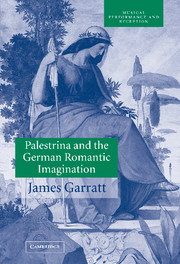Book contents
- Frontmatter
- Contents
- Acknowledgements
- List of abbreviations
- Introduction
- 1 Historicism in nineteenth-century art, aesthetics and culture
- 2 Romanticism and the problem of church music
- 3 The Protestant Palestrina revival
- 4 The Catholic Palestrina revival
- 5 Palestrina in the concert hall
- 6 Interpreting the secondary discourse of nineteenth-century music
- Notes
- Bibliography
- Index
Introduction
Published online by Cambridge University Press: 12 October 2009
- Frontmatter
- Contents
- Acknowledgements
- List of abbreviations
- Introduction
- 1 Historicism in nineteenth-century art, aesthetics and culture
- 2 Romanticism and the problem of church music
- 3 The Protestant Palestrina revival
- 4 The Catholic Palestrina revival
- 5 Palestrina in the concert hall
- 6 Interpreting the secondary discourse of nineteenth-century music
- Notes
- Bibliography
- Index
Summary
This study explores historicism in nineteenth-century German music, focusing on the reception of Renaissance church music, in particular the works of Giovanni Pierluigi da Palestrina (c. 1525–94). It explains how and why the works of a sixteenth-century composer came to be viewed as the paradigm of church music, assessing and interpreting the relationship between the idealization of his style and contemporary composition. The approach taken is threefold in nature. First, it confronts and offers solutions to an aesthetic problem, establishing why nineteenth-century composers sought to relate their works to the music of Palestrina and how they were able to justify such relationships in the face of Romantic postulates of originality, authenticity and contemporaneity in the artwork. Second, it addresses a historical problem, examining the complex differing natures of the Protestant and Catholic Palestrina revivals, and comparing the compositional responses to Palestrina by north German Protestants and south German Catholics. Third, it addresses a theoretical problem, exploring how relationships to earlier musical styles and materials in nineteenth-century compositions can best be discussed and understood, proposing a new model for interpreting compositional historicism.
The Palestrina revival – a phrase used throughout the study to indicate both the reawakening of interest in Palestrina's music and its emulation by nineteenth-century composers – has not been entirely neglected by modern musicology.
- Type
- Chapter
- Information
- Palestrina and the German Romantic ImaginationInterpreting Historicism in Nineteenth-Century Music, pp. 1 - 8Publisher: Cambridge University PressPrint publication year: 2002

